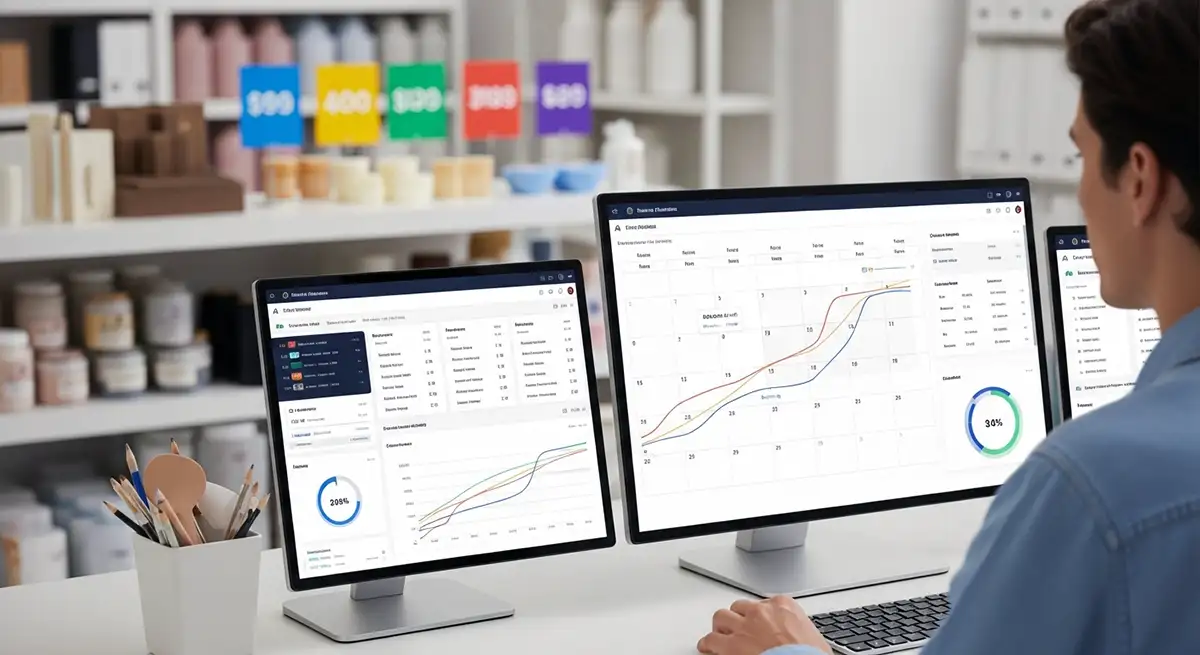
AI Demand Forecasting in Retail: Use Cases that Deliver ROI
What is AI Demand Forecasting in Retail?
Definition and Explanation
AI demand forecasting in retail refers to the application of artificial intelligence technologies to predict customer demand for products and services. By leveraging vast amounts of historical sales data, market trends, and various external factors, AI systems can analyze patterns and generate forecasts with remarkable accuracy. This predictive capability empowers retailers to make informed decisions regarding inventory management, supply chain logistics, and marketing strategies—ultimately enhancing their operational efficiency and customer satisfaction.
At its core, AI demand forecasting harnesses machine learning algorithms and statistical modeling techniques, enabling retailers to anticipate fluctuations in demand, whether due to seasonal trends, promotional events, or sudden market shifts. As retailers face an increasingly competitive landscape, the adoption of AI demand forecasting is becoming essential for maintaining an edge in the market.
Key Components of AI Demand Forecasting
The effectiveness of AI demand forecasting in retail hinges on several key components. Firstly, data quality is paramount; accurate and comprehensive data sets serve as the foundation for reliable predictions. Retailers must ensure they collect data from diverse sources, including point-of-sale systems, customer behavior analytics, and external datasets such as economic indicators and weather patterns.
Secondly, machine learning algorithms play a crucial role in identifying patterns within this data. These algorithms continuously learn and adapt based on new information, allowing for the refinement of forecasts over time. Furthermore, the integration of advanced analytics tools enhances the interpretability of results, enabling stakeholders to grasp complex insights easily.
Finally, a robust feedback loop is essential. Retailers must regularly evaluate the accuracy of their forecasts and adjust their models accordingly. This iterative process not only improves forecasting precision but also fosters a culture of continuous improvement within the organization.
Benefits of AI Demand Forecasting in Retail
Enhanced Accuracy and Precision
One of the foremost benefits of AI demand forecasting in retail is its unparalleled accuracy and precision. Traditional forecasting methods often rely on historical data and subjective judgment, which can lead to significant discrepancies. In contrast, AI systems analyze vast datasets in real-time, identifying intricate patterns that human analysts might overlook. This heightened accuracy translates to more reliable demand predictions, reducing the likelihood of stockouts or overstock situations.
Research has shown that retailers utilizing AI-driven demand forecasting experience a substantial reduction in forecast error rates, leading to better alignment between supply and demand. As a result, businesses can optimize their inventory levels, ensuring that popular items are readily available while minimizing excess stock that ties up valuable resources.
Cost Reduction and Operational Efficiency
The integration of AI demand forecasting also yields considerable cost savings and operational efficiencies. By accurately predicting demand, retailers can streamline their supply chain processes, reducing the costs associated with excess inventory, warehousing, and logistics. This optimization allows organizations to allocate resources more effectively, whether by negotiating better terms with suppliers or reallocating labor based on anticipated demand levels.
Moreover, AI demand forecasting aids in demand planning, enabling retailers to schedule production and procurement more efficiently. This proactive approach minimizes waste and enhances overall business agility, allowing retailers to respond swiftly to changing market dynamics.
Improved Customer Satisfaction and Loyalty
Implementing AI demand forecasting in retail fosters improved customer satisfaction and loyalty. By ensuring that products are available when customers want them, retailers can create a seamless shopping experience. When customers consistently find what they are looking for, their trust in the brand strengthens, leading to increased loyalty and repeat business.
Additionally, AI-driven insights can inform personalized marketing strategies, allowing retailers to tailor promotions and recommendations based on predicted demand patterns. This level of customization enhances the overall customer experience, as shoppers feel understood and valued, further solidifying their connection to the brand.
How to Implement AI Demand Forecasting in Retail
Step-by-Step Implementation Process
Implementing AI demand forecasting in retail requires a strategic approach. The first step involves assessing current forecasting methods and identifying areas for improvement. Retailers should conduct a comprehensive audit of their existing data sources, technologies, and processes to determine what is needed for a successful AI integration.
Next, businesses must invest in the right AI tools and technologies. This may involve selecting machine learning platforms or analytics software capable of processing large datasets and generating actionable insights. Collaborating with technology partners or consultants can provide valuable expertise during this phase.
After establishing the technological framework, retailers should focus on data integration. This involves consolidating data from various sources and ensuring that it is clean and accessible for analysis. Building a centralized data repository can facilitate this process and enhance the overall effectiveness of forecasting models.
Finally, continuous monitoring and optimization are essential. Retailers should regularly evaluate the performance of their AI demand forecasting models, using feedback to refine algorithms and improve accuracy. This dynamic approach ensures that forecasting remains relevant and effective in the face of evolving market conditions.
Choosing the Right AI Tools and Technologies
Selecting the appropriate AI tools and technologies is critical to the success of AI demand forecasting in retail. Retailers should prioritize platforms that offer scalability, flexibility, and user-friendliness. Ideally, these tools should integrate seamlessly with existing systems, allowing for a smooth transition and minimal disruption to operations.
Additionally, retailers should consider the specific requirements of their business model. For example, companies with complex supply chains may benefit from advanced analytics capabilities that account for multiple variables, while smaller retailers may prioritize simplicity and ease of use. Engaging with vendors that provide comprehensive support and training can also enhance the implementation process.
Integrating AI with Existing Systems
To maximize the benefits of AI demand forecasting, retailers must ensure effective integration with their existing systems. This includes connecting AI tools with inventory management, point-of-sale, and customer relationship management systems. A cohesive data ecosystem enables real-time data sharing and collaboration across departments, fostering a more agile and responsive organization.
Additionally, cross-functional collaboration is essential for successful implementation. Involving stakeholders from various departments—such as marketing, supply chain, and finance—ensures that everyone is aligned on forecasting objectives and can contribute valuable insights. This collaborative approach enhances the overall effectiveness of AI demand forecasting initiatives.
AI Demand Forecasting Retail Best Practices
Data Quality and Management
Data quality and management are foundational to the success of AI demand forecasting in retail. Retailers must prioritize the collection of accurate, consistent, and comprehensive data from various sources. Establishing data governance practices can help ensure that data remains reliable and up-to-date.
Furthermore, retailers should invest in data cleansing and normalization processes to eliminate discrepancies and enhance the quality of insights generated by AI models. This commitment to data integrity lays the groundwork for more precise forecasting and better decision-making.
Continuous Learning and Model Optimization
AI demand forecasting is not a one-time effort but rather an ongoing process. Continuous learning and model optimization are critical components of a successful forecasting strategy. Retailers should regularly assess the performance of their AI models, identifying areas for improvement and making necessary adjustments.
Incorporating new data sources and refining algorithms based on real-world outcomes can enhance the accuracy of forecasts over time. This iterative approach fosters a culture of innovation and adaptability, ensuring that retailers remain responsive to changing market conditions and customer preferences.
Collaboration Across Departments
Effective collaboration across departments is essential for the successful implementation of AI demand forecasting in retail. By breaking down silos and fostering communication between teams, retailers can leverage diverse perspectives and insights to enhance forecasting accuracy.
For example, marketing teams can provide valuable information regarding upcoming promotions, while supply chain teams can share insights about lead times and inventory levels. This collaborative approach facilitates more informed decision-making and ensures that all stakeholders are aligned on forecasting goals.
AI Demand Forecasting Retail Examples
Case Study: [Retail Brand] and Their AI Success
One notable example of successful AI demand forecasting in retail is [Retail Brand], which implemented AI-driven solutions to enhance its inventory management processes. Faced with challenges related to stockouts and excess inventory, the company sought to harness the power of AI to optimize its forecasting accuracy.
By integrating AI tools with its existing systems, [Retail Brand] was able to analyze historical sales data alongside external factors such as seasonal trends and economic indicators. This comprehensive approach resulted in a significant reduction in forecast errors, leading to improved inventory turnover rates and increased customer satisfaction.
The success of [Retail Brand] highlights the transformative potential of AI demand forecasting in retail. By embracing technology and data-driven insights, the company was able to achieve substantial ROI and strengthen its competitive position in the market.
Industry-Specific Applications and Innovations
AI demand forecasting is not limited to a single retail sector; its applications span various industries, each benefiting from tailored solutions. For instance, fashion retailers can leverage AI to predict trends based on social media analytics and customer behavior, enabling them to adjust their inventory accordingly.
Grocery retailers, on the other hand, can utilize AI demand forecasting to anticipate demand fluctuations influenced by factors such as weather patterns or local events. By employing industry-specific applications, retailers can enhance their forecasting accuracy and better meet the unique demands of their customer base.
Future Trends in AI Demand Forecasting for Retail
Predictive Analytics and Machine Learning Advances
As technology continues to evolve, the future of AI demand forecasting in retail is poised for exciting advancements. Predictive analytics and machine learning techniques are becoming increasingly sophisticated, enabling retailers to generate even more accurate forecasts.
The integration of natural language processing (NLP) and advanced data visualization tools will further enhance the interpretability of forecasting insights, allowing stakeholders to grasp complex patterns intuitively. This evolution will empower retailers to make data-driven decisions with greater confidence, ultimately driving profitability and growth.
The Role of IoT in Demand Forecasting
The Internet of Things (IoT) is set to play a pivotal role in the future of AI demand forecasting in retail. With the proliferation of connected devices, retailers can access real-time data from a multitude of sources, such as smart shelves, point-of-sale systems, and customer behavior analytics.
This wealth of data will enable retailers to refine their forecasting models, providing even more precise insights into customer demand. The ability to track inventory levels and customer preferences in real-time will enhance operational efficiency and foster a more responsive retail environment.
Conclusion
Summary of Key Points
AI demand forecasting in retail represents a transformative opportunity for businesses to enhance their operational efficiency, reduce costs, and improve customer satisfaction. By leveraging advanced technologies and data-driven insights, retailers can achieve heightened accuracy in their demand predictions, ultimately driving better decision-making.
Implementing AI demand forecasting requires a strategic approach, emphasizing data quality, continuous learning, and collaboration across departments. Successful case studies and industry-specific applications demonstrate the tangible benefits of adopting AI solutions in retail.
Final Thoughts on AI Demand Forecasting in Retail
As the retail landscape evolves, the importance of AI demand forecasting will only continue to grow. Retailers that embrace this technology will be better equipped to navigate the challenges of an increasingly dynamic market. By investing in AI-driven solutions and fostering a culture of innovation, retailers can position themselves for sustained success in the years to come. For more insights on AI applications across various industries, visit our industry AI applications page.






No comment yet, add your voice below!